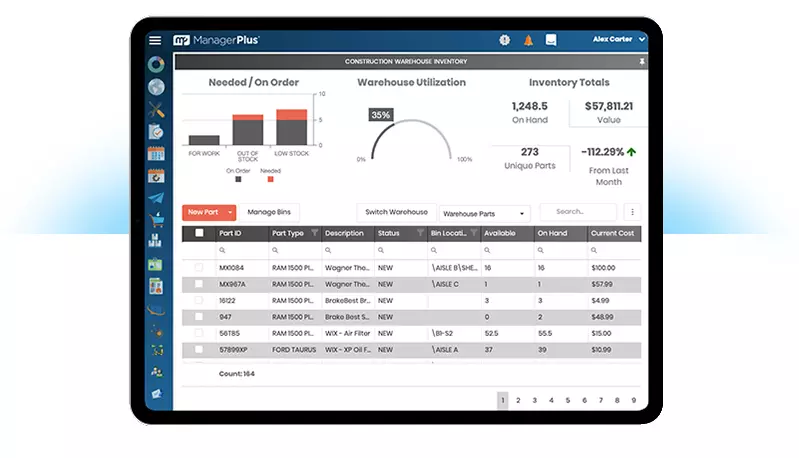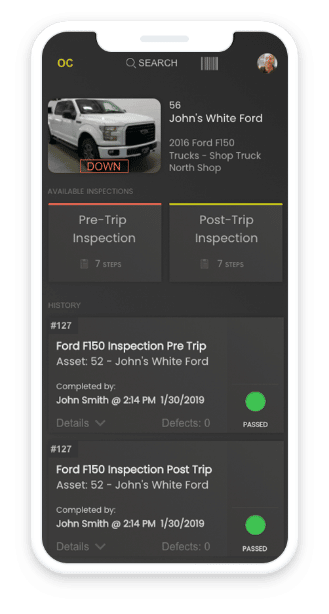Before you can see a return on your asset and equipment investments, you first need ways to efficiently capture and share data. The problem is that older systems don’t scale. Small, unavoidable inefficiencies are compounded, creating fractured workflows.
But there is a solution, and it lives in the cloud.
What is cloud computing?
Cloud computing is where the majority of an organization’s IT infrastructure, including the servers required to store and process data, are offsite and accessed through the Internet.
What is cloud vs. on-prem?
If cloud computing is housing computing infrastructure off-site at the location of the supplier, on-prem or on-premises is the opposite. Here, a company keeps all the physical infrastructure, including servers, racks, computers, etc., on-site. This includes all the personnel required to manage the infrastructure: engineers, developers, and other support staff.
What are the main types of cloud computing?
There are three main types of cloud-based computing:
- Infrastructure-as-a-Service (IaaS)
- Platform-as-a-Service (PaaS)
- Software-as-a-Service (SaaS)
The differences are all related to what percentage of the IT infrastructure you keep and manage yourself onsite.
IaaS
Infrastructure-as-a-Surface (IaaS) systems allow companies to store the necessary IT hardware offsite so they can use their own internal software without having to own the hardware necessary to run it. The required computers, servers, cables, and even support staff are all with the provider, and the customer essentially leases space on the equipment.
It’s basically the same as shipping. You provide the products that are going out to customers, but a logistics company is in charge of the fleet. You’re just renting space on their infrastructure, which in this case is their fleet.
PaaS
Platform-as-a-Service systems take things one step further, offering customers both the hardware infrastructure and the fundamental software they need to build their own applications. If your company plans to develop and maintain proprietary software, PaaS helps your IT team build and scale it both quickly and efficiently.
A parallel example of this would be a company that provides upfitting services for fleet vehicles. They purchase the base vehicles from the manufacturer and then build their own proprietary systems on top, saving themselves the enormous cost of developing and building the base vehicle internally.
SaaS
Software-as-a-service is the most comprehensive form of cloud computing and offers customers a complete hardware and software solution. It is the most common form of cloud computing due to its ease of implementation and cost-saving benefits.
SaaS systems deliver complete software services and applications over the internet where customers can access them from any Internet-connected device. SaaS systems are used in almost every aspect of society from your email and Netflix accounts to full-service enterprise asset management (EAM) software.

Why is SaaS better than on-prem?
Software-as-a-Service systems are popular because of the immense gains derived from their ease of use and long-term cost-effectiveness. Nearly every around the world is becoming increasingly more connected and cloud-based systems allow companies to take advantage of data in ways that simply are not possible with an on-prem solution.
Let’s look at some of the biggest benefits your organization can see from implementing a cloud-based EAM solution.
1. Cost savings
In almost every scenario, moving your EAM software to the cloud will save you money almost immediately, and in the long run. If you don’t yet have an EAM solution you should consider investing in a SaaS platform.
There are quite a few ways in which moving to the cloud can save you money.
- Minimal upfront costs
- Only pay for what your need
- No operating expenses
- No costs due to server downtime
Avoid costly capital investments – When purchasing and implementing an on-prem EAM software, there can be enormous upfront costs that must be considered a capital investment. You will need to purchase the computer(s) to run the software, the servers to store the data you collect, and the highly trained IT personnel to manage and maintain it all, just to name a few things. Depending on the size of your organization, these costs can grow exponentially with each new system you need to add. And all this is only the initial investment. As you grow and scale, you will need to continue to invest in more hardware and personnel to keep up with your growth.
With a SaaS system, on the other hand, you don’t need to purchase any of that. All the costs associated with operating and maintaining the necessary hardware are put onto the software provider. All you have to do is decide how many users you need, and what type of access they need to have, and that’s it. Each team member is given the access they need and is ready to go in minutes.
Avoid paying for software you don’t need – This ties into the next point that you only pay for what you need. Every person in your organization has a different role with different responsibilities so not everyone needs to have the same level of access to your EAM software. For example, only the maintenance manager and supervisor might need to be able to sign off on work orders. The rest of the technicians don’t need that capability.
With a cloud-based EAM software like ManagerPlus, you only pay for what you need. Our experts work closely with you to determine the different roles within your organization, then build your pricing plan accordingly so you’re not having to purchase multiple different licenses or versions of the software to then install on each person’s computer.
Avoid ongoing operating expenses – If you choose to go with an on-prem solution, then all the expenses involved with operating and maintaining that fall on your shoulders. That means hiring highly skilled IT professionals to operate, manage, and update your system regularly. If you don’t want to hire someone, then you have to stretch your internal team to cover those tasks, pulling them away from keeping your other internal systems running smoothly.
SaaS EAM providers take on the burden of all those costs themselves, so you don’t have to worry about it. Your internal team can stay focused on what they do best and the software provider focuses on maintenance and upkeep of the hardware.
Avoid costly equipment downtime – Any asset management professional can understand the value of less downtime. Enterprise-level servers and IT infrastructure which power SaaS EAM software has a reliability rating of 99.99% so you don’t ever have to worry about losing productivity or valuable data due to a power outage or a system failure. These systems are incredibly well built to be reliable and secure.
And for the other 0.01% of the time, the best software providers have multiple backups of your data and several system redundancies in place to ensure none of your data is ever lost. So, even if their system does shut down for a moment, all of your data is still safe and secure.
2. Easy implementation
SaaS systems are, by nature, quite easy to install and set up on your systems. Most often, all you and your team need to use the software is a computer or other Internet-connected device with a web browser. There’s no need for purchasing and installing large, expensive equipment or complicated, error-prone software downloads. Much like you would with your email provider, you can simply navigate to a website and log in with your credentials to access everything you need, all in one place.
This kind of implementation also allows you to try out the software before you sign up for a long-term contract. Most services you use across the internet allow for some sort of trial period, and that is only possible through a cloud-based service model. If you’re wanting to try out an EAM software like ManagerPlus, you can usually do so for free to see the benefits for yourself.
The only truly tedious and time-consuming part of implementing EAM software is getting all the data you currently have on your asset imported into the system. With an on-premises solution, many times you will end up having to do this yourself which takes valuable time away from you and your team. With a cloud-based offering, the best providers will do this heavy lifting for you. Asset management experts, like the ones from ManagerPlus, can come on-site and gather all your data on your assets, including your parts and inventory, and get it all imported safely and securely into the software for you, so you and your team can focus on getting the job done.

3. Scalability
Every business, if they want to succeed, should always be looking for areas in which to grow and expand. As this happens and you acquire more assets, technicians, facilities, and everything else you need as you grow, you need to expand your EAM tools to accommodate them. With an on-premises solution, this means purchasing extra hardware and potentially even more licenses of the software to be able to run on the additional hardware.
Eventually, you will also need to hire additional IT personnel to help you manage and maintain the extra hardware and software you acquire as you grow. On-prem solutions are simply not designed to scale economically.
SaaS systems, on the other hand, require almost no additional investment in money or time to scale with your company. If you obtain more assets, you just input them into the system and move on. As you acquire more technicians, all they need is a smartphone, tablet, or computer to be up and running in minutes.
The ability to scale quickly with SaaS systems also makes it seamless to unlock new features in your EAM as you grow. The best solutions will have features and products designed for companies to take advantage of as they grow and because they live in the cloud, there’s no extra software to download and install, the features can simply be unlocked for your account.
4. Data security
As more and more of our world and our industry have become digitized, data is more valuable to organizations than it’s ever been. The data you gather on your assets helps you keep them running, and helps you spot areas to save money and improve profitability.
With all this invaluable data being gathered on your operations, it’s vital that it remains safe and secure. While you may think that keeping your data stored locally on-site is safer than storing it in the cloud, that is often no longer the case. Recent data suggests that local, onsite IT infrastructure is being attacked by hackers at more than three times the rate that cloud infrastructure is.
In recent years, the security of cloud-based infrastructure has grown exponentially to the point that storing data on the cloud is almost always much safer than storing it locally. The only exception to this might be for organizations with government or other clients that require extreme security. In that case, consult with your IT department to determine the solution needed for your company.
There’s one other aspect of data security to consider: if you store all the data, software, and hardware, on-site as part of an on-prem solution, what happens to all of that if your computer suddenly dies for some reason? Or worse yet, your facility experiences some sort of unforeseen disaster? All your information, including all the hardware you invested so much money in, is suddenly gone which could be catastrophically expensive to replace. Not to mention the intangible cost of all the data you lost.
With all the hardware, software, and data stored off-site and, in the cloud, those costs are mitigated. Every good SaaS EAM provider, or at least any worth considering, should have multiple backup solutions and redundancies in place as part of their platform. That is one reason cloud-based platforms can offer better security for your data because they can afford to have systems in place to keep it safe.
One of the other main benefits of SaaS systems is that any updates to the software, whether feature updates or security updates, can be pushed out to every user of the software instantly the moment it’s available. You don’t have to log on somewhere and download the update and wait for it to install, it all happens seamlessly, without you even knowing it’s happening.
5. Mobility
Another problem with on-premises solutions is that they are often tied to the machine they are installed on. If you install the software on one computer in the maintenance office, every time someone needs to use it, they have to walk to the office and log on with their credentials. Not only does this mean lots of wasted time walking back and forth, but everyone must be counted on to remember their logins and passwords, and practices must be developed and put in place to keep the data secure. For example, making sure everyone logs out of the software every time they walk away from their computer.
This also opens up the possibility for greater human error because all the information must be physically brought to the computer where the software is installed and entered in manually every time. So, now you’re counting on your technicians to take detailed notes on your assets and the tasks they completed and input all that information correctly every time.
Needless to say, this is not the most efficient way to do this.
 With cloud-based EAM software, your team can access the software from wherever they are, on their own devices. Instead of paying for licenses that are tied to specific machines, you’re paying for accounts for each person who uses it so they can access whatever they need from anywhere. No more running back-and-forth across the facility to get to the maintenance office. They can access and upload any information they need to at the moment.
With cloud-based EAM software, your team can access the software from wherever they are, on their own devices. Instead of paying for licenses that are tied to specific machines, you’re paying for accounts for each person who uses it so they can access whatever they need from anywhere. No more running back-and-forth across the facility to get to the maintenance office. They can access and upload any information they need to at the moment.
Bonus benefit: One of the additional benefits that may not be immediately apparent from this is the fact that using a cloud-based solution might mean your team needs less training to use it properly. While the software itself may require some training, most of your team most likely uses smartphones and tablets in their daily lives so they already understand most of the basics of how to navigate and use the software. Plus, the best EAM solutions are mobile-friendly which means they are intuitively designed and easy to use.
6. Analytics and data gathering
The last major benefit of having cloud-based EAM software is that it allows you to collect and analyze data much easier. If you house the infrastructure on-site, then the amount of data you can collect is limited by the amount of space you have allocated to data storage. How many times have you had a notification pop up on your smartphone telling you that you were running low on storage? SaaS systems avoid this problem because there is almost unlimited storage available to you.
The provider can focus the efforts of their entire company into building and maintaining the infrastructure necessary, so they can offer you far more storage than you could cost-effectively maintain on your own.
These same economies of scale allow the software provider to house vast amounts of processing power for crunching that data. That means you can instantly generate detailed cost-analysis and Business Intelligence reports driven by powerful algorithms that would be expensive to maintain locally.
How do I get started?
As you can see, in almost every scenario, cloud-based, EAM solutions are better and more cost-effective for companies than on-premises solutions. If you’re ready to move your company into the cloud, set up a call with our experts at a time that fits your schedule. They’ll walk you through our software during a personalized, one-on-one demo where you can ask questions and see for yourself how moving to the cloud can benefit your organization.
Executive summary
Cloud computing is no longer the future of industry. It’s here. And the benefits offered from cloud-based EAM solutions are enormous compared to what you can get with an on-site solution, or by using paper and spreadsheets to manage your data and workflows.
Some of the biggest benefits companies can see from Software-as-a-Service (SaaS) EAM include:
- Cost savings
- Easy implementation
- Scalability
- Data security
- Mobility
- Analytics and data gathering
Moving your asset management and maintenance operations to a cloud-based EAM software like ManagerPlus is cost-effective and sets your company up well for years to come.


